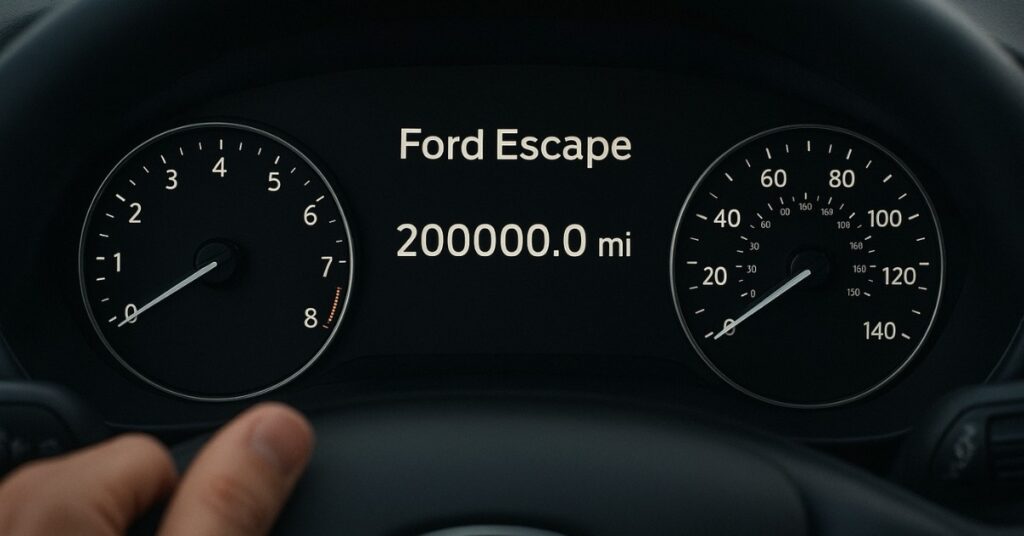How Long Does a Ford Escape Last? — A Deep Dive into Ford Escape Longevity

If you’re in the market for a compact SUV that can go the distance, the Ford Escape longevity question is one you must ask. Whether you’re eyeing a new model or considering a high-mileage used unit, knowing how long a Ford Escape can reliably last is essential before you commit.
In this article, we’ll explore:
- How long do Ford Escapes last with proper maintenance,
- What the typical mileage life of a Ford Escape is,
- Which years are most reliable (and which to avoid),
- Common issues that shorten the Ford Escape lifespan,
- And strategies on how to make your Ford Escape last longer.
Let’s dive in.
The Typical Lifespan of a Ford Escape

How Long Do Ford Escapes Last with Proper Maintenance?
A Ford Escape should be practically effective with a lifespan of 150,000 to 200,000 miles (about 10 to 15 years of average usage per year). That notwithstanding, most owners indicate that they drive far more than that ceiling.Some Escapes are said to have travelled 200,000 to 300,000 miles with good care.
Nevertheless, high-mileage achievements are usually regarded as exceptions. The real life expectancy of a vehicle greatly depends on how the vehicle has been driven, serviced and maintained during its service life.
What Is the Average Mileage Life of a Ford Escape?
Majority of the actual data shows that 200,000 miles is an average of a well-maintained Escape. To a huge number of users, the vehicle will start demanding a higher number of repairs or replacement of its parts when it reaches such a threshold. According to some sources, older models (before 2013) are likely to range at 150,000-200,000 miles, and newer models (since 2014) can go as far as 200,000-250,000 + miles under optimal conditions.
In short: an Escape may easily serve up to 12-15 years or even beyond and with exceptional maintenance much longer.
Can a Ford Escape Last 200,000 Miles? What About 300,000?
Yes and many have done it. Owners have shared stories of Escapes racking up 200,000+ miles, and in rare cases, even 300,000. One user of a 2012 Escape claimed:
“I would not be surprised if it reached 300,000 miles with proper care.”
That said, pushing so far demands unusually meticulous care, timely major component overhauls, and often, a dose of good fortune (i.e. avoiding serious accidents or defects).
So yes — a Ford Escape can last 200,000 miles, and in select cases, surpass 300,000 — but that isn’t guaranteed.
How Reliable Is a Ford Escape Long Term?
Ford Escape Reliability Rating & Maintenance Cost
According to RepairPal, the Ford Escape has a reliability rating of 4.0 out of 5.0, placing it solidly in the mid-range among compact SUVs. Its average annual repair and maintenance cost is estimated around $600, which is slightly above the segment average.
In various reliability studies and rankings:
- It’s often considered above average in most owner surveys.
- J.D. Power and U.S. News have highlighted strong recent model years in quality and reliability scores.
In practice, many owners find that most repairs are moderate in cost — routine wear items, sensors, brakes, suspension bushings — rather than catastrophic failures.
Best & Worst Years for Ford Escape Reliability
When assessing Ford Escape reliability by year, some model years clearly stand out as more dependable — while others are best avoided.
Best Years to Buy (Most Reliable)
These years based on aggregate owner data and reliability survey appear to be more favorable:
- 2019: Good rates of reliability, reduced NHTSA complaints, which are valued by reviewers.
- 2022 / 2023: The latest models that received good quality and reliability ratings at J.D. Power.
- 2015: After redesigning, the reliability was better than in the previous problem years.
- 2010-2012: Aged but less sophisticated, with less electronics/forced induction problems.
Years to Approach with Caution (or Avoid)
There are model years that are associated with recurrent problems:
- 2014: Generally mentioned as among the poorest years with transmission issues.
- 2013: Numerous recalls, electrical/mechanical problems.
- 2005–2009 (early models): Generally less robust; more basic engineering but greater wear and tear over time.
- 2021: There are certain reports of fuel-system and electrical reliability problems.
Overall: more recent models (2019 and beyond) are likely to provide better technology and quality of the build; however, they may also have more sophisticated and newer systems that can collapse. In the mean time, the older simpler models will not be complex but can be not durable in high-mileage operations.
Common Problems That Shorten a Ford Escape’s Lifespan
To understand how Ford Escape life expectancy can be eroded, here are key trouble spots:

1. Transmission / Drivetrain Issues
Many problematic model years suffer transmission failure — especially 2013–2015, and 2014 is often cited for serious failings. Over time, slipping, harsh shifts, or complete failure can occur if fluid changes are neglected.
2. Turbocharged / EcoBoost Engine Stress
Some models use smaller, turbocharged EcoBoost engines (1.6L, 1.5L). Poor tuning, neglect, or high boost stress can lead to blown turbos, oil consumption, or intake issues.
3. Cooling / Overheating & Block Cracks
Certain 2016–2019 units are reported to experience coolant intrusion or engine block design issues, affecting long-term durability.
4. Electrical / Sensor Failures
Modern Escapes come with many sensors, control modules, and wiring harnesses. These can fail or degrade over time — especially in older years with recalled electronics.
5. Suspension & Steering Wear
High-mileage use accelerates wear on bushings, tie rods, ball joints, and shocks. These parts are common to wear out and become costly if neglected.
6. Recalls & Safety Defects
Recent recall for fuel injector cracking (2020–2022 Escape with 1.5L engine) may pose fire risk. Also, some Escape models were part of recalls for rearview camera software issues. These defects, if unaddressed, can impact safety and reliability.
Knowing these vulnerabilities helps you spot red flags when assessing a used or aging Escape.
How to Make Your Ford Escape Last Longer
Maximizing Ford Escape long term reliability is largely about proactive care. Here’s a checklist:

1. Follow the Factory Maintenance Schedule (Religiously)
Oil changes, transmission fluid, coolant, and differential service must be done at recommended intervals. Don’t stretch them.
2. Use High-Quality Fluids & Filters
Premium engine oil, quality OEM air/oil filters, and correct coolant formulations reduce wear and corrosion.
3. Monitor Key System Health
Check for coolant leaks, boost leaks (turbo models), vacuum leaks, and keep an eye on oil consumption or rising temps.
4. Stay Ahead of Small Failures
Replace worn suspension parts, belts, pulleys, and worn sensors before they cascade into major damage.
5. Drive Moderately
Avoid frequent hard acceleration, towing beyond capacity, or pushing the engine hard — these accelerate stress.
6. Keep Recalls Addressed
If your Escape is part of a recall (e.g. injector software updates, camera software patches), get it serviced as soon as possible.
With these habits, many owners report pushing beyond 250,000 miles or more.
Ford Escape vs Rivals: Longevity Comparison
Let’s see how the Escape stacks up against its compact SUV peers in terms of longevity and reliability.
| Model | Typical Lifespan (Miles) | Known Weaknesses | Strengths |
| Ford Escape | 150,000 – 250,000+ | Transmission, turbo stress, recalls | Good on repairs, decent value |
| Toyota RAV4 | 200,000 – 300,000+ | Occasional oil consumption | Very strong reliability |
| Honda CR-V | 200,000 – 300,000+ | Occasional transmission or A/C issues | Excellent engine durability |
| Mazda CX-5 | 150,000 – 250,000+ | Turbo and electronics in higher trims | Good driving dynamics |
Toyota and Honda SUVs tend to have slightly better reputations in reliability and longevity, but a well-maintained Ford Escape can compete — especially when purchased wisely.
Used Ford Escape Buying Guide for Longevity
If you’re considering a used Escape and want one that lasts:
- Choose the right year — Favor 2019, 2022–2023, or 2010–2012. Avoid 2013–2014 trouble years.
- Inspect service history — Look for consistent maintenance, documented fluid changes, and major part replacements.
- Get a pre-purchase inspection — Especially check transmission fluid, intake/turbo for leaks, cooling system, etc.
- Check for recalls & software updates — Confirm injector recall was addressed, camera software patches.
- Prefer simpler trims — Less optional complexity means fewer things to go wrong.
- Consider hybrid / non-turbo — Hybrid or naturally aspirated versions can sometimes be more durable long term (though battery life must also be considered).
A good used Escape picked right and maintained well can deliver many years of dependable service.
Summary & Takeaways
- The normal range of Ford Escape longevity is 150,000 to 200,000 miles with average owners; a range of 200,000-300,000 can be achieved with a lot of caution.
- When well maintained, most of them have a life span of 12-15+ years and a mileage of more than 200,000.
- Certain years of the model (2019, 2022-2023, 2015) are more reliable; certain ones (2013, 2014) are known to have difficulties.
- The common lifespan limitations include transmission problems, turbo strains, cooling system malfunction, and electrical sensor malfunction.
- The preventive maintenance, moderate driving habits, and recollection keeping are also important to increase life.
With proper ownership and a wise selection of model years, a Ford Escape can definitely become a long-term and long-lasting SUV companion.
Final Verdict: Is the Ford Escape Built to Last?
The Ford Escape is one of the most well-rounded compact SUVs – with its comfort, efficiency and long-term usability under the right care. Although this is not perfect (particularly in certain past turbo or transmission-infected years), the Escape will reward astute owners with good reliability and long service.
With proper care and forward-looking maintenance, repairs at the first opportunity, and one of the reliable years of models, the Escape can be easily used to pass the 200,000-mile mark, and even more. It is not the length of time a Ford Escape lasts, in other words it is the way you maintain it well.
Discover expert car tips, towing guides, and vehicle insights at CarFact.online.
Frequently Asked Questions (FAQs)
Q: How long does a Ford Escape last on average?
A: With proper maintenance, a Ford Escape can reliably last 150,000 to 200,000 miles, and often more than 10 to 15 years.
Q: Will a Ford Escape last 200,000 miles?
A: Yes — many owners report reaching 200,000+ miles when regular maintenance is followed and problems are addressed early.
Q: What are the most reliable Ford Escape years?
A: Some of the best years include 2019, 2022, 2023, and 2015, along with older years like 2010–2012.
Q: What shortens a Ford Escape’s lifespan?
A: Neglected maintenance, harsh driving, transmission stress, turbo abuse, cooling system failure, and unresolved electrical or recall defects all degrade longevity.
Q: Is a high-mileage Ford Escape reliable?
A: It can be — if it has been maintained well, with timely repairs, a trustworthy service history, and no major defects. But risks rise once you approach higher mileage thresholds.
Have questions about the Ford Escape Longevity? Contact us—we’re here to help you find the right answers.
